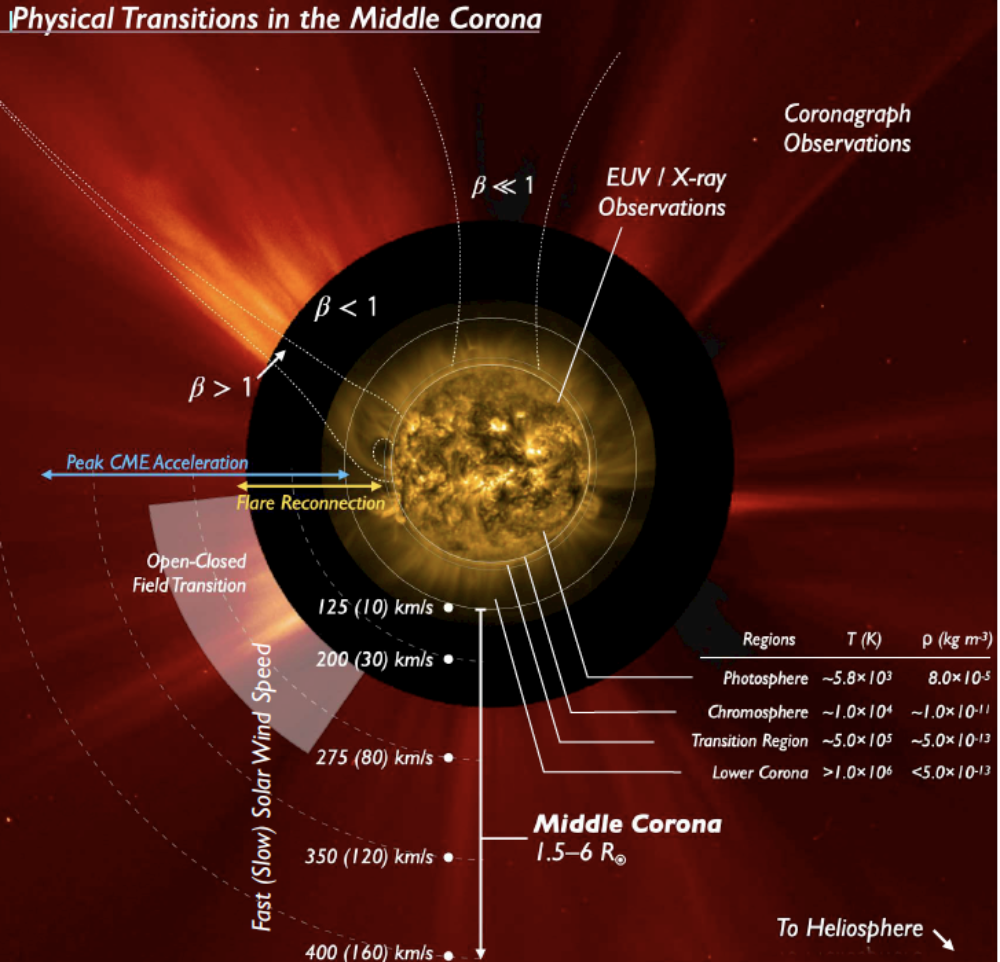The region of the middle corona (MC), roughly between 0.5 and 2 solar radii (R⊙) above the photosphere, is a virtually unexplored region, despite its fundamental role in shaping the inner corona and the solar wind, as reviewed recently by West et al. (2023). It is a crucial boundary where the solar wind is formed, but also where changes in magnetic topology such as interchange reconnection can affect the lower corona (cf. Del Zanna+2011).
The quiescent corona emits strongly in spectral lines of highly ionized ions in the EUV. In the inner corona, these lines are mainly formed by collisional excitation by the free electrons. Some strong lines in the EUV/UV are known to be visible out to several R⊙ as they are mainly excited by the disk radiation. The modeling of such lines is non-trivial as it depends on the distribution of disk radiation, the type of transition, the local state of the plasma, and line of sight (LOS) effects. A combination of modeling and observations provides, however, powerful diagnostics as the possibility to measure outflow velocities via the Doppler dimming (see, e.g. Noci et al., 1987), as well as other diagnostics such as measurements of densities (cf. Dudík et al., 2021).
Forbidden lines in the visible and near infrared (NIR) are also strongly radiatively excited and are also visible out to several R⊙. Via spectropolarimetry, they offer the possibility to measure the coronal magnetic field, which so far has only been estimated, mainly by extrapolating the photospheric measurements. The visible and especially the NIR is virtually unexplored, but offer many diagnostic possibilities to measure the plasma state (densities, temperatures chemical abundances) plus the magnetic field, see e.g. Judge (1998); Del Zanna & DeLuca (2018).
We have obtained some information on the MC with total solar eclipses, the Mauna Loa K-coronameter (KCor), and briefly by SOHO LASCO/C1. The only instrument that surveyed the MC for an extended period of time was the Ultraviolet Coronagraph Spectrometer (UVCS) on SOHO. Coronal signal in UVCS was detected out to 3 Rsun (Del Zanna+2018). The presence of large-scale structures in the low MC and their dynamical behaviour was caught by PROBA2/SWAP images in the EUV (cf. West+2022) and GOES/SUVI off-point campaigns (Seaton+2021). Solar Orbiter EUI 174 A images with an occulter have also detected signal in the MC (Auchere+2023).
The low MC is being probed in the visible and near-infrared (NIR) by DKIST and the Upgraded Coronal Multi-channel Polarimeter (UCoMP).
Within the visible and NIR, two breakthrough space-based coronagraphs, the Visible Emission Line Coronagraph (VELC) onboard Aditya, and the ESA Proba-3 Association of Spacecraft for Polarimetric and Imaging Investigation of the Corona of the Sun (ASPIICS), will soon become operational and probe the MC. The Airborne Infrared Spectrometer (AIR-Spec), a next-generation airborne spectrometer, performed novel measurements during two eclipses, in 2017 and 2019 (cf. Samra et al., 2022). A follow-up instrument, the Airborne Coronal Emission Surveyor (ACES: Samra et al.,2021), will survey for the first time the entire NIR spectral region in early 2024 during the total eclipse. The Coronal Spectropolarimeter for Airborne Infrared Research (CORSAIR), will perform ground-breaking spectropolarimetric measurements of the MC in coronal forbidden lines with a one-month Antarctic circumpolar flight.
To make progress in our understanding of the MC, a careful combination of key observations and modelling needs to be coordinated. The team work will focus on the following goals:
1. Compare methods and codes for the calculation of line intensities affected by resonant excitation, from the EUV to the NIR; carry out an assessment study and make the codes available to the community. We note that various methods have been published but codes are not publicly available.
2. Compare methods and codes, such as FORWARD (Gibson et al., 2016), or P-CORONA (see Supriya et al. 2021 and http://research.iac.es/proyecto/polmag), that estimate the spectropolarimetry with a coronal magnetic field.
3. Refine and compare techniques for the forward modelling of plasma state observables, on the basis of 3-D models of the whole corona, which in turn rely on global MHD and nonlinear force-free field simulations, as well as data-driven heating functions.
4. Combine existing codes to estimate the location of the freezing-in radius, including time-dependent ionization (cf. Gilly & Cranmer, 2020).
5. Plan and coordinate multi-wavelength, multi-mission observations of the middle and lower corona. Emphasis will be on Aditya VELC, PROBA-3 and DKIST observations, in combination with Solar Orbiter and Hinode.
6. Benchmark the codes against available observations, starting with the existing ones (e.g. SWAP, SUVI, EUI, METIS). Emphasis might be given to the 2024 eclipse observations.
7. Make recommendations for future instruments, observing strategies and spectral diagnostics.
Before the first meeting took place, we have organised several telecons to identify suitable observations and the present ourselves.
The online meetings will be extended occasionally to other colleagues more involved in the inner corona (e.g. DKIST) and the solar wind (e.g. Parker Solar Probe and Solar Orbiter), although relevant expertise is already present in some team members.
We expect a few focused reports/publications on the benchmarks of the models and the comparison between models and observations. We also aim to make relevant codes available to the community. As the MC is virtually unexplored, the techniques and the multi-instrument observations we will coordinate will form the basis for years of novel research.

